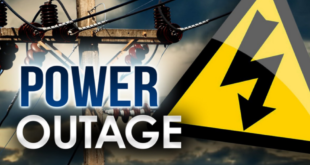UPDATED: 1100 EDT 10 October 2018
Hurricane Michael will make landfall shortly as a Category 4 Hurricane. The National Hurricane Center provides the following advisory, which they issued at 1100 EDT
At 1000 AM CDT (1500 UTC), the eye of Hurricane Michael was located near latitude 29.4 North, longitude 86.0 West. Michael is moving toward the north-northeast near 14 mph (22 km/h). A turn toward the northeast is expected this afternoon or tonight. A motion toward the northeast at a faster forward speed is forecast on Thursday through Friday night. On the forecast track, the core of Michael is expected to move ashore along the Florida Panhandle early this afternoon, move northeastward across the southeastern United States tonight and Thursday, and then move off the Mid-Atlantic coast away from the United States on Friday. Data from NOAA and Air Force Reserve Hurricane Hunter aircraft indicate that maximum sustained winds are near 145 mph (230 km/h) with higher gusts. Michael is an extremely dangerous category 4 hurricane on the Saffir-Simpson Hurricane Wind Scale.Hurricane Michael is predicted to make landfall as a Category 4 within the hours.Hurricane Michael has been steadily increasing in magnitude from when we originally issued an alert on 08 October 2018. At that time the Hurricane was rated a Category 1, it is now rated a Category 4 Hurricane.
Mandatory evacuation is underway in Florida and Alabama. Shelters are open. Storm surge will be between 9 and 14 feet.
Time to evacuate is closing.
When a hurricane is 6 hours from arriving
- If you’re not in an area that is recommended for evacuation, plan to stay at home or where you are and let friends and family know where you are.
- Close storm shutters, and stay away from windows. Flying glass from broken windows could injure you.
- Turn your refrigerator or freezer to the coldest setting and open only when necessary. If you lose power, food will last longer. Keep a thermometer in the refrigerator to be able to check the food temperature when the power is restored.
- Turn on your TV/radio, or check your city/county website every 30 minutes in order to get the latest weather updates and emergency instructions.
Survive DURING
- If told to evacuate, do so immediately. Do not drive around barricades.
- If sheltering during high winds, go to a FEMA safe room, ICC 500 storm shelter, or a small, interior, windowless room or hallway on the lowest floor that is not subject to flooding.
- If trapped in a building by flooding, go to the highest level of the building. Do not climb into a closed attic. You may become trapped by rising flood water.
- Listen for current emergency information and instructions.
- Use a generator or other gasoline-powered machinery outdoors ONLY and away from windows.
- Do not walk, swim, or drive through flood waters. Turn Around. Don’t Drown! Just six inches of fast-moving water can knock you down, and one foot of moving water can sweep your vehicle away.
- Stay off of bridges over fast-moving water.
Alabama
PSA: You may text “ALALERT” to 888777 to receive information for Hurricane Michael from the Alabama Emergency Management Agency.#weatheraware #weichertcares #alabama #auburnopelika… https://t.co/TQLWc6DVWS
— Weichert Porter (@weichertporter) October 9, 2018
Florida
Hurricane shelter locations are accessible from: https://t.co/Hop887IoiC #HurricaneMichael pic.twitter.com/Ljk8boFaSw
— Florida SERT (@FLSERT) October 9, 2018
Georgia
In response to the potential impacts of #HurricaneMichael, @GovernorDeal has declared a State of Emergency for 92 counties throughout South Georgia. Pay close attention to guidance from local officials and be prepared to take emergency action. pic.twitter.com/NUs8dvFmJ7
— Georgia EM&HS (@GeorgiaEMA) October 9, 2018
Ready.gov Hurricane Preparedness tips
IF YOU ARE UNDER A HURRICANE WARNING, FIND SAFE SHELTER RIGHT AWAY
- Determine how best to protect yourself from high winds and flooding.
- Evacuate if told to do so.
- Take refuge in a designated storm shelter, or an interior room for high winds.
- Listen for emergency information and alerts.
- Only use generators outdoors and away from windows.
- Turn Around, Don’t Drown! Do not walk, swim, or drive through flood waters.
When a hurricane is 6 hours from arriving
- If you’re not in an area that is recommended for evacuation, plan to stay at home or where you are and let friends and family know where you are.
- Close storm shutters, and stay away from windows. Flying glass from broken windows could injure you.
- Turn your refrigerator or freezer to the coldest setting and open only when necessary. If you lose power, food will last longer. Keep a thermometer in the refrigerator to be able to check the food temperature when the power is restored.
- Turn on your TV/radio, or check your city/county website every 30 minutes in order to get the latest weather updates and emergency instructions.
Survive DURING
- If told to evacuate, do so immediately. Do not drive around barricades.
- If sheltering during high winds, go to a FEMA safe room, ICC 500 storm shelter, or a small, interior, windowless room or hallway on the lowest floor that is not subject to flooding.
- If trapped in a building by flooding, go to the highest level of the building. Do not climb into a closed attic. You may become trapped by rising flood water.
- Listen for current emergency information and instructions.
- Use a generator or other gasoline-powered machinery outdoors ONLY and away from windows.
- Do not walk, swim, or drive through flood waters. Turn Around. Don’t Drown! Just six inches of fast-moving water can knock you down, and one foot of moving water can sweep your vehicle away.
- Stay off of bridges over fast-moving water.
Be Safe AFTER
- Listen to authorities for information and special instructions.
- Be careful during clean-up. Wear protective clothing and work with someone else.
- Do not touch electrical equipment if it is wet or if you are standing in water. If it is safe to do so, turn off electricity at the main breaker or fuse box to prevent electric shock.
- Avoid wading in flood water, which can contain dangerous debris. Underground or downed power lines can also electrically charge the water.
- Save phone calls for emergencies. Phone systems are often down or busy after a disaster. Use text messages or social media to communicate with family and friends.
- Document any property damage with photographs. Contact your insurance company for assistance.
 Travel Securely Securely Travel
Travel Securely Securely Travel


